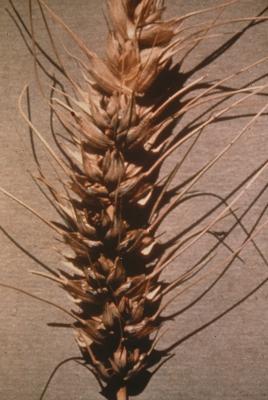Nematodes - wheat
Contributors to this page: CIMMYT, Mexico (Etienne Duveiller, Monica Mezzalama, Eloise Phipps, Thomas Payne, Jesper Norgaard), Independent consultant (Jesse Dubin).
Seed gall nematode, wheat nematode
Causes ear cockle and yellow slime or tundu
|
Seed Gall Nematode (also known as Wheat Nematode or Ear Cockle) As diseased plants
Seed Gall Nematode (also known as Wheat |
Scientific name
Anguina tritici (Steinbuch) Chitwood
Importance
The pest should not be a problem where good seed production systems are in place. It is extinct or rare in most parts of Europe, Australasia, Russia and North America.
Some countries consider Anguina tritici an important quarantine/quality concern and impose a nil tolerance for galls in imported grain. Trade implications are the major impact of this nematode.
Significance
This nematode is rarely of economic importance.
Symptoms
Distorted leaves and stems are evident prior to heading. As diseased plants approach maturity, galls are formed in the florets, replacing the kernels. Seed galls in cereals are known as ear cockle. The galls are similar in shape to the seed they replace but are dark brown in color. Large numbers of motile larvae are present within the galls and become active after the galls have been moistened.
Although potentially an important pest in its own right, Anguina tritici also acts as a vector for Rathayibacter tritici, which causes yellow slime rot or tundu.
Hosts
The seed gall nematode parasitizes wheat, triticale, rye, and related grasses; it primarily affects wheat.
Geographic distribution
Ear cockle was in the past reported in all the major wheat-growing areas. However, Anguina tritici has now become rare or locally extinct in many countries. It is still found in the Near and Middle East, the Asian Subcontinent, China, and parts of Africa.
Biology and transmission
The female is about 3.8 mm long and spirally coiled. Although females exhibit some movement, they are effectively immobile. The stylet is relatively short at 8 to 10 μm long. Males are not as robust as the females, curved rather than coiled and only about 2.4 mm long.
At maturity, the galls induced by the nematode contain large numbers of second stage juveniles (J2s, c. 800 μm long), which are the survival, dispersal and invasive stage of Anguina tritici. Galls already in the soil or sown with contaminated seeds are the sources of infestation. In the field, galls become moist and soft, facilitating release of second stage juveniles. Juveniles move progressively to the growing tip until they penetrate the floral primordia, where they develop to maturity. Females lay thousands of eggs in the developing seed gall; these hatch and when the juveniles reach the J2 stage they enter anhydrobiosis. There is one generation per year.
Detection/indexing methods used
- At CIMMYT: Physical inspection of seed.
- At ICARDA: Visual inspection, nematode soaking test
Treatment/control
- Seed cleaning and crop rotation together can achieve complete control to the point of localised extinction. Modern harvesting, seed cleaning and testing practices are more than adequate to ensure that seed is free of the nematode. The most effective control is by mechanical seed cleaning. Galls may be also removed by submersion of the seed in 20% brine solution (galls float to the surface), followed by thorough washing in water. Hot water treatment at 54°C for 10 min is also reported to be effective in killing the nematodes.
- Modern harvesting, seed cleaning and testing practices are more than adequate to ensure seed free of the nematode. For small seed lots, where this technology is not available, brine (10%) flotation is more efficient than hand sieving.
- In addition to clean seed, carryover from one crop to the next in the same or adjacent fields needs to be avoided. Despite having a remarkable longevity when stored dry, only a small proportion of juveniles will survive to a second season in the field, hence rotation with a non-host crop and control of volunteer wheat will provide effective field control.
Procedures followed at the centers in case of positive test
- At CIMMYT: The seed lot is destroyed (the nematode is quarantined in Mexico).
- At ICARDA: Infected kernels are eliminated
References and further reading
CIMMYT. Wheat Doctor information sheet: Seed gall nematode. [online] Available fromURL: http://wheatdoctor.cimmyt.org/. Date accessed 07 April 2010
Diekmann M, Putter CAJ. (eds.). 1995. FAO/IPGRI Technical Guidelines for the Safe Movement of Germplasm. No. 14: Small Grain Temperate Cereals. Rome: Food and Agriculture Organization of the United Nations (FAO) and International Plant Genetic Resources Institute (IPGRI). pp. 53-54.
Paruthi IS, Bhatti DS. 1985. Estimation of loss in yield and incidence of Anguina triticina on wheat in Haryana (India). International Nematology Network Newsletter 2: 13-16.
Prescott JM, Burnett PA, Saari EE, Ransom J, Bowman J, de Milliano W, Singh RP, Bekele G. 1986. Wheat Diseases and Pests: A Guide for Field Identification. Mexico, D.F.: CIMMYT. pp. 98-99. [online] Available from URL: http://www.cimmyt.org/. Date accessed 07 April 2010
Riley IT, Reardon TB. 1995. Isolation and characterization of Clavibacter tritici associated with Anguina tritici in wheat from Western Australia. Plant Pathology 44: 805-810.
Southey JF, Topham PB, Brown DJF. 1990. Taxonomy of some species of Anguina Scopoli, 1777 (sensu Brzeski, 1981) forming galls on Gramineae: value of diagnostic characters and present status of nominal species. Revue de Nematologie 13: 127-142.
Swarup G, Sethi CL, Gotke N. 1993. Ear cockle (nematode gall) and yellow slime. In: Mathur SB, Cunfer BM. (eds.), Seed-borne Diseases and Seed Health Testing of Wheat. Copenhagen: Danish Government Institute of Seed Pathology for Developing Countries. pp. 153-161.
Wiese MV. 1987. Compendium of wheat diseases. 2nd edn. St Paul, MN: APS Press. pp. 63-64.
Comments
- No comments found







Leave your comments
Post comment as a guest